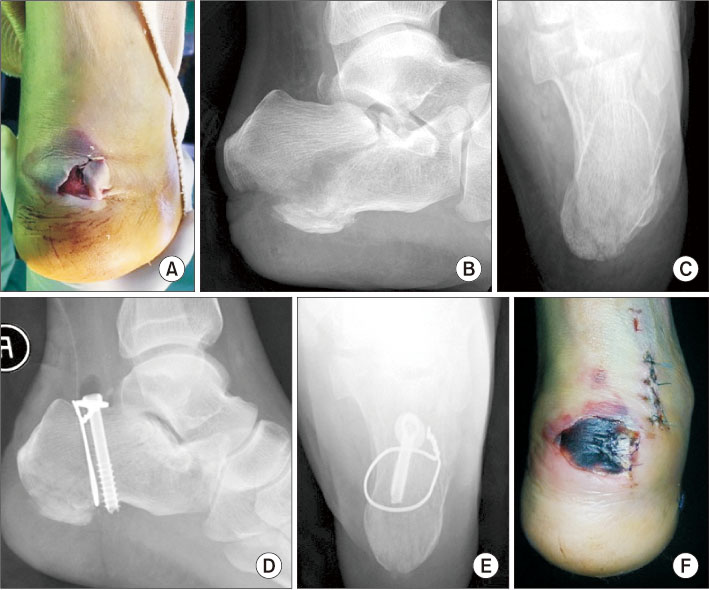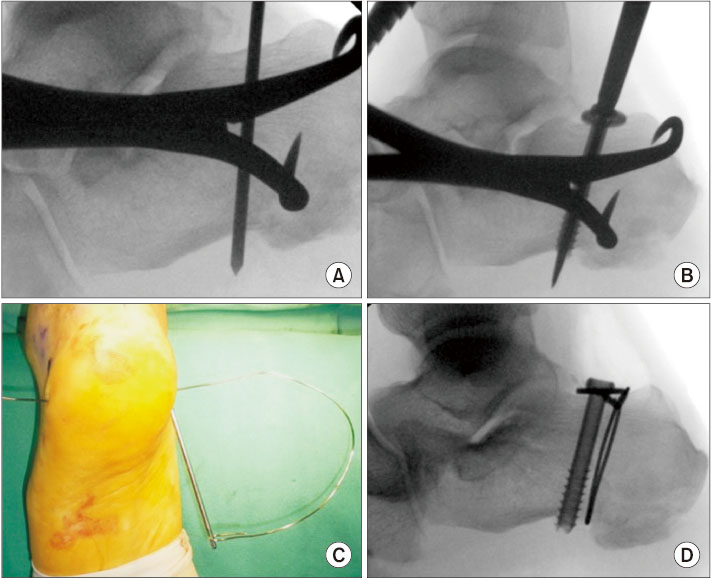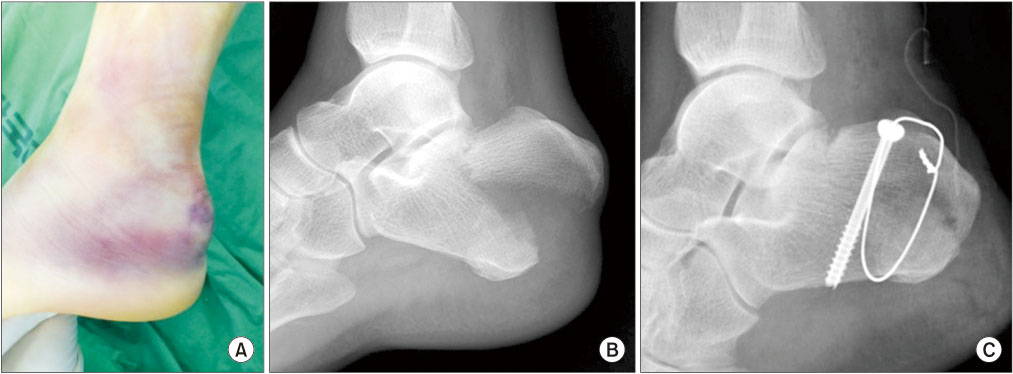J Korean Foot Ankle Soc.
2017 Dec;21(4):165-169. 10.14193/jkfas.2017.21.4.165.
Treatment of Secondary Soft Tissue Compromised Calcaneus Fractures Using a Cannulated Screw and Simple Cerclage Wiring: A Report of Two Cases
- Affiliations
-
- 1Department of Orthopedic Surgery, Dankook University College of Medicine, Cheonan, Korea. jwansuh@gmail.com
- KMID: 2398015
- DOI: http://doi.org/10.14193/jkfas.2017.21.4.165
Abstract
- Secondary soft tissue injuries can occur from the pressure of the displaced fragment of posterior calcaneal tuberosity in calcaneal tongue-type fractures and calcaneal tuberosity avulsion fractures. The soft tissue injury can be prevented by immediate reduction of the displaced fragments. Various techniques can be used to fix the fracture fragments, but the stability of fixation and minimal invasiveness to soft tissue should be considered. This paper reports the successful outcomes of patients with soft tissue compromises in calcaneal tongue-type fractures and calcaneal tuberosity avulsion fractures. The fixation technique of a large cannulated screw and simple cerclage wiring is believed to be a useful surgical option for the treatment of secondary soft tissue compromised calcaneal fractures.
Keyword
Figure
Reference
-
1. Gardner MJ, Nork SE, Barei DP, Kramer PA, Sangeorzan BJ, Benirschke SK. Secondary soft tissue compromise in tongue-type calcaneus fractures. J Orthop Trauma. 2008; 22:439–445.
Article2. Chhabra N, Sherman SC, Szatkowski JP. Tongue-type calcaneus fractures: a threat to skin. Am J Emerg Med. 2013; 31:1151.e3–1151.e4.
Article3. Snoap T, Jaykel M, Williams C, Roberts J. Calcaneus fractures: a possible musculoskeletal emergency. J Emerg Med. 2017; 52:28–33.
Article4. Brunner CF, Weber BG. Internal fixation plates with a specialized form or function. In : Brunner CF, Weber BG, editors. Special techniques in internal fixation. Berlin: Springer-Verlag Berlin Heidelberg;1982. p. 145–165.5. Rammelt S, Zwipp H. Calcaneus fractures: facts, controversies and recent developments. Injury. 2004; 35:443–461.
Article6. Squires B, Allen PE, Livingstone J, Atkins RM. Fractures of the tuberosity of the calcaneus. J Bone Joint Surg Br. 2001; 83:55–61.
Article7. Khazen GE, Wilson AN, Ashfaq S, Parks BG, Schon LC. Fixation of calcaneal avulsion fractures using screws with and without suture anchors: a biomechanical investigation. Foot Ankle Int. 2007; 28:1183–1186.
Article8. Levi N, Garde L, Kofoed H. Avulsion fracture of the calcaneus: report of a case using a new tension band technique. J Orthop Trauma. 1997; 11:61–62.
Article9. Nagura I, Fujioka H, Kurosaka M, Mori H, Mitani M, Ozaki A, et al. Modified tension band wiring fixation for avulsion fractures of the calcaneus in osteoporotic bone: a review of three patients. J Foot Ankle Surg. 2012; 51:330–333.
Article10. Banerjee R, Chao JC, Taylor R, Siddiqui A. Management of calcaneal tuberosity fractures. J Am Acad Orthop Surg. 2012; 20:253–258.
Article
- Full Text Links
- Actions
-
Cited
- CITED
-
- Close
- Share
- Similar articles
-
- Treatment of Tibial Plateau Fractures by Cannulated screw Fixation
- Fixation of the Greater Trochanter in Arthroplasty for Unstable Intertrochnateric Fracture
- Cannulated Screw Fixation with Figure-Eight Wiring of Displaced Transverse Patella Fractures
- Treatment of Displaced Transverse Patellar Fractures with Cannulated Screws and Figure-Eight Wiring
- Operative Treatment of Intraarticular Calcaneal Fractures Combined with Multiple Injuries using Closed Reduction and Cannulated Screw Fixation





